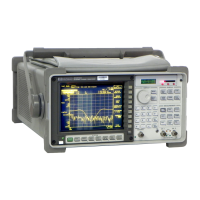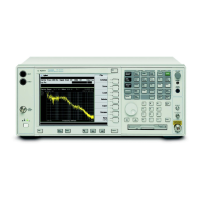To view the real and imaginary components of a driving point
measurement
1 Measure a driving point measurement.
2 Press [
Active Trace
][
A
].
Press [
Trace Coord
][
MORE CHOICES
][
REAL PART
].
3 Press [
Active Trace
][
B
].
Press [
IMAGINARY PART
].
4 Press [
Active Trace
][
AB
].
Press [
Scale
][
AUTOSCALE ON OFF
] to highlight ON.
A characteristic of a driving point measurement is that the imaginary components all
point in the same direction. When the imaginary components do not all point in the
same direction, it usually indicates that the accelerometer and the impact point for the
hammer were separated. In addition, the relative frequencies are the same, but the
relative amplitudes at each resonance are different.
0Hz 3.2kHzAVG: 10
A: Freq Resp2/1 X:0 Hz Y:-1.496
120
-80
Real
20
/div
X:0 Hz Y:0
B: Freq Resp2/1
40
-160
Imag
20
/div
Trac Coord
[FFT]
A: Real B: Imag
C: Real D: Real
A characteristic of a driving point
measurement is that all imaginary
components point in the same
direction.
0Hz 3.2kHzAVG: 10
A: Freq Resp2/1 X:0 Hz Y:-1.2918
120
-80
Real
20
/div
X:0 Hz Y:0
B: Freq Resp2/1
250
-250
Imag
50
/div
0Hz 3.2kHzAVG: 10
Trac Coord
[FFT]
A: Real B: Imag
C: Real D: Real
When the accelerometer and impact point
are separated by 90
o
, the imaginary
components do not point in the same
direction.
Agilent 35670A
Operator's Guide Measuring Structures
2-13

